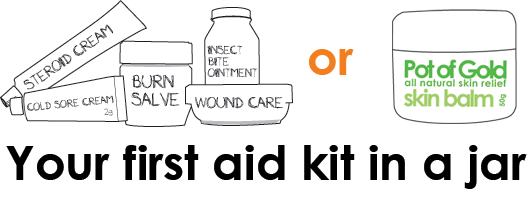Beeswax
Here in New Zealand our bees are lucky enough to collect pollen from native bush such as the Manuka and Kanuka and produce not only the world's best honey but also the best beeswax. Organic New Zealand beeswax is known to contain a large number of vitamins, minerals, fatty acids and micro-nutrients and is also excellent at retaining moisture while simultaneously allowing the skin to breathe and repair itself.
All beeswax used in our products is certified organic and locally produced.
Beeswax must be one of the most misunderstood cosmetic ingredients. Some people immediately call to mind a picture of a heavy and very solid wax when thinking of beeswax. This is incorrect and beeswax has very wonderful properties when correctly used and included in skin care formulas.
 Primitive people knew and used beeswax as an antiseptic and for wound healing. It works well in cosmetic products because of compounds called 'wax esthers' that exist in both beeswax and human skin. This hydrating pure natural skin care ingredient increases skins essential moisture keeping skin naturally moisturised. Primitive people knew and used beeswax as an antiseptic and for wound healing. It works well in cosmetic products because of compounds called 'wax esthers' that exist in both beeswax and human skin. This hydrating pure natural skin care ingredient increases skins essential moisture keeping skin naturally moisturised.
People with acne sometimes incorrectly think that it is a comedogenic ingredient (an ingredient that promotes the formation of acne and pimples), whereas it actually has an irritation potential of zero, and a comedogenicity rating of 0-2, which means that when it is properly used it will NOT promote the formation of acne or pimples.
When formulated and used correctly in cosmetic formulations, beeswax will not cause a problem or clog the pores, but instead bring a host of very positive attributes, such as healing and antiseptic properties, as well as emollient and softening qualities to a cosmetic product.
General information on beeswax
The honeybee (Apis Mellifera), secretes beeswax to build the walls of the honeycomb. When wax is secreted by the bee it is a transparent colourless liquid, which turns into a semi-solid substance on contact with the atmosphere. It is purified from its raw state by freeing it of solid impurities through melting and centrifugation.
Compounds found in beeswax
Vitamins
Provitamin A (carotenoids), Vitamin B-1 (thiamine), Vitamin B-2 (riboflavin), Vitamin B-3 (niacin), Vitamin B-5 (panothenic acid), Vitamin B-6 (pyridoxine), Vitamin B-7, Vitamin B-8, Vitamin B-9, Vitamin B-12 (cyamoco balamin), Vitamin C (ascorbic acid), Vitamin D, Vitamin E, Vitamin H (biotin), Vitamin K, Choline, Inositol, Folic Acid, Pantothenic Acid, Rutin, Vitamin P (nicotinicamide) .
Minerals
Calcium, Phosphorus, Iron, Copper, Potassium, Magnesium, Manganese, Silicoa, Sulphur, Sodium, Titanium, Zinc, Iodine, Chlorine, Boron, Molybdenum.
Enzymes & Coenzymes
Disstase, Phosphatase, Amylase, Catalase, Saccharase, Diaphorase, Pectase, Cozymase, Cytochrome systems, Lactic dehydrogenase, Succinic dehydrogenase.
Fats & Oils
Fatty Acid, Hexadecanol, Alpha-amino butyric acid.
Fatty Acids
Caproic (C-6), Caprylic (C-8), Capric (C-10), Lauric (C-12), Myristic (C-14), Palmitic (C-16), Palmitoleic (C-15), Uncowa, Stearic (C-18), Oleic (C-18), Linoleic (C-18), Aracidic (C-20), Benemic (C-22), Limolenic (C-18), Eicosanoic (C-20), Brucic (C-22).
Proteins, Globulins, Peptones & Amino Acids
Tryptophan, Leucine, Lysine, Isoleucine, Methionine, Cystine, Thresonine, Arginine, Phenylalanine, Histidine, Valine, Glutamic acid, Tyrosine, Glycine, Serine, Proline, Alanine, Aspartic acid, Hydroxyproline, Butyric acid.
Carbohydrates
Gums, Pentosans, Cellulose, Sooronine, Starch, Sucrose, Levulose, Fructose, Grape sugar, Reducing Sugars.
Micro-Nutrients
Nucleosides, Auxins, Brassins, Gibberellins, Kinins, Vernine, Guanine, Xanthine, Hypoxalthine, Crocetin, Zeaxanthin, Lycopene, Hexodecanol, Alpha-Amino-Butyric Acid, Monoglycerides, Deglycerides, Triglycerides, Peutosaus
Miscellaneous
Waxes, Resins, Vernine, Guanine, Xanthine, Hypoxanthine, Nuclein, Amines, Lecithin, Glucoside of Isorhanetin, Glycosides of Quercetir, Selenium, Nucleic Acids, Flavonoids, Phenolic Acids, Tarpenes and many other as yet unidentified nutrients.
 |
|